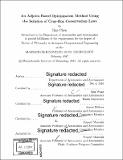| dc.contributor.advisor | Qiqi Wang. | en_US |
| dc.contributor.author | Chen, Han, Ph. D. Massachusetts Institute of Technology | en_US |
| dc.contributor.other | Massachusetts Institute of Technology. Department of Aeronautics and Astronautics. | en_US |
| dc.date.accessioned | 2017-12-05T19:11:33Z | |
| dc.date.available | 2017-12-05T19:11:33Z | |
| dc.date.copyright | 2017 | en_US |
| dc.date.issued | 2017 | en_US |
| dc.identifier.uri | http://hdl.handle.net/1721.1/112409 | |
| dc.description | Thesis: Ph. D., Massachusetts Institute of Technology, Department of Aeronautics and Astronautics, 2017. | en_US |
| dc.description | Cataloged from PDF version of thesis. | en_US |
| dc.description | Includes bibliographical references (pages 131-138). | en_US |
| dc.description.abstract | Many design applications can be formulated as an optimization constrained by conservation laws. Such optimization can be efficiently solved by the adjoint method, which computes the gradient of the objective to the design variables. Traditionally, the adjoint method has not been able to be implemented in "gray-box" conservation law simulations. In gray-box simulations, the analytical and numerical form of the conservation law is unknown, but the full solution of relevant flow quantities is available. Optimization constrained by gray-box simulations can be challenging for high-dimensional design because the adjoint method is not directly applicable. My thesis considers the gray-box models whose flux functions contain unknown algebraic dependence on the state variables. I develop a twin-model method that estimates the adjoint gradient from the gray-box space-time solution. My method utilizes the gray-box space-time solution in order to infer the unknown components of the flux. The solution is used to train a parameterized, adjoint-enabled conservation law simulator such that a metric of solution mismatch is minimized. After the training, the twin model can estimate the gradient of the objective function by the adjoint method, at a cost independent of the dimensionality of the gradient. Also, an adaptive basis construction procedure is presented for the training to fully exploit the information contained in the gray-box solution. The availability of the estimated gradient enables more efficient optimization. My thesis considers a Bayesian optimization framework, in which the objective, the true gradient, and the error in the estimated gradient are modeled by Gaussian processes. Building upon previous research, a twin-model-enhanced Bayesian optimization algorithm is developed. I show that the algorithm can find the optimum of the objective function regardless of the gradient accuracy if the true hyperparameters of the Gaussian models are given. The twin-model method and the twin-model-enhanced optimization are demonstrated in several gray-box models: a Buckley-Leverett equation whose flux function is unknown, a steady-state Navier-Stokes equation whose state equation is unknown, and a porous media flow equation governing a petroleum reservoir whose componentwise mobility factors are unknown. In these examples, the twin model is shown to accurately estimate the gradients. Besides, the twin-model-enhanced Bayesian optimization can achieve near-optimality within fewer iterations than without using the twin model. Finally, I explore the applicability of the twin-model method in an example with 1000-dimensional control by using a gradient descent approach. The last example implies that the twin model may be adopted by other optimization frameworks to improve convergence, which indicates a direction of future research. | en_US |
| dc.description.statementofresponsibility | by Han Chen. | en_US |
| dc.format.extent | 138 pages | en_US |
| dc.language.iso | eng | en_US |
| dc.publisher | Massachusetts Institute of Technology | en_US |
| dc.rights | MIT theses are protected by copyright. They may be viewed, downloaded, or printed from this source but further reproduction or distribution in any format is prohibited without written permission. | en_US |
| dc.rights.uri | http://dspace.mit.edu/handle/1721.1/7582 | en_US |
| dc.subject | Aeronautics and Astronautics. | en_US |
| dc.title | An adjoint-based optimization method using the solution of gray-box conservation laws | en_US |
| dc.type | Thesis | en_US |
| dc.description.degree | Ph. D. | en_US |
| dc.contributor.department | Massachusetts Institute of Technology. Department of Aeronautics and Astronautics | |
| dc.identifier.oclc | 1008567067 | en_US |
